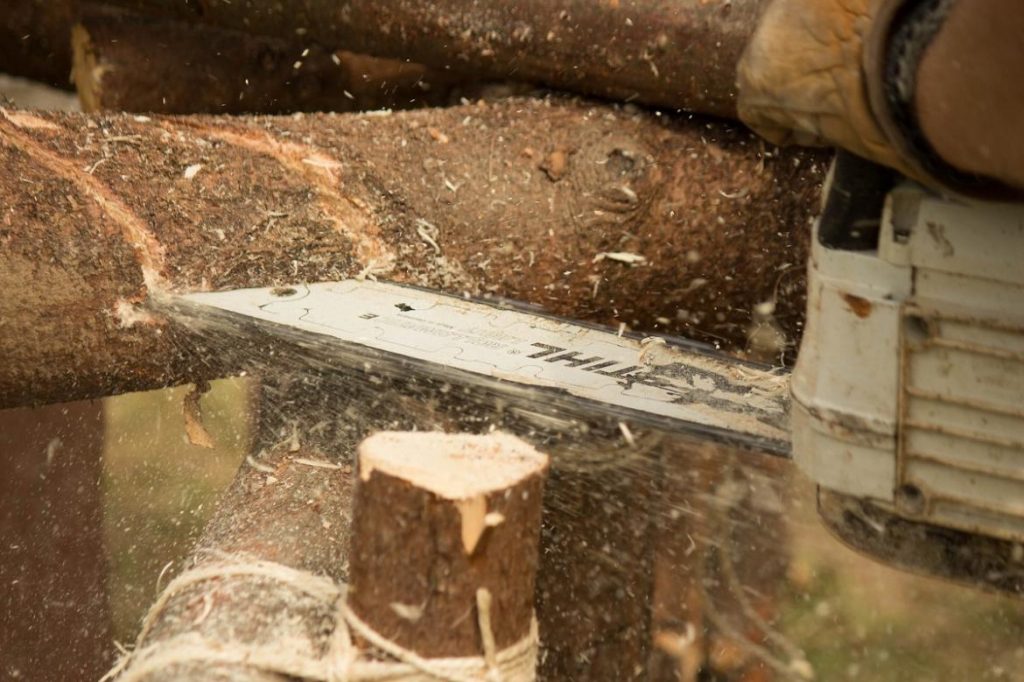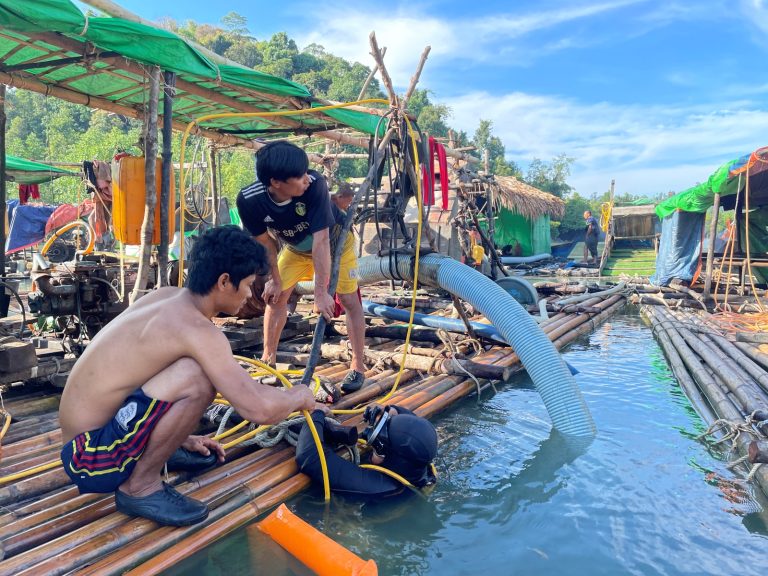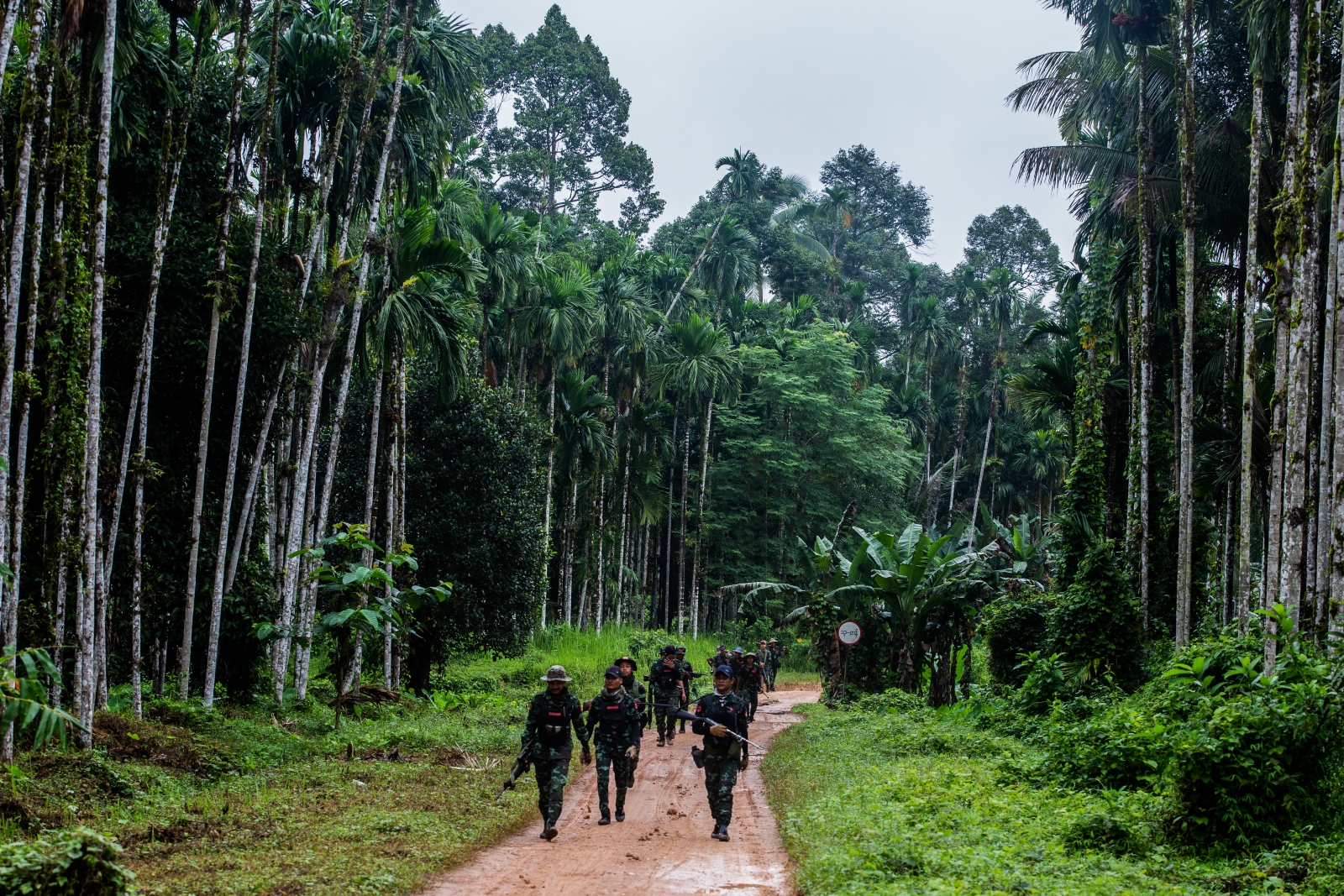Despite Myanmar’s nationwide commercial logging ban in 2016, illegal loggers continue to find work cutting down trees with chainsaws, imported largely from China and often obtained illegally and used without training or protective gear, according to a months-long investigation by Mongabay.
By POPPY McPHERSON | MONGABAY
MANDALAY — As darkness fell in the forests of central Myanmar on a rainy evening last July, May Thu and her husband Myint Swe*, were wrapping up their day’s work: illegal logging.
May Thu, a petite 27-year-old with long black hair and shining black eyes, clambered on top of some logs assembled in a pile. It was monsoon season and the wood was slippery. She fell and landed on the buzzing blade of her husband’s chainsaw.
At first, there was no pain, but she knew she was in trouble.
“OK, I just got injured by a chainsaw, this will be big,” she recalls thinking.
Support more independent journalism like this. Sign up to be a Frontier member.
Myint Swe, a gentle man with foxlike features and a nervous disposition, scooped her up.
“It’s just a small one,” he lied as he carried her back to their village. They had been happily married for 10 years. But when she asked him to stop so she could look at the wound, she saw a deep incision across the backs of her legs, backside and vagina. There was a tremendous amount of blood.
May Thu and Myint Swe live in a tiny village north of Mandalay, the country’s second largest city; a two-hour drive along bumpy roads plied by minivans and trucks, some carrying cut logs on their roofs. Their logging work is illegal.
The country has the third highest deforestation rate in the world, close behind Brazil and Indonesia, the worst offenders according to the UN Food and Agricultural Organization’s 2015 Global Forest Resources Assessment.
Between 2010 and 2015, the country lost a half a million hectares of forest annually. The government, led by Aung San Suu Kyi, has tried to slow the losses, introducing a ban on logging shortly after it came to power in 2016. It’s set to expire in April this year. Currently, the country’s timber needs are supposed to be served by stockpiles gathered by the state-run Myanmar Timber Enterprise.
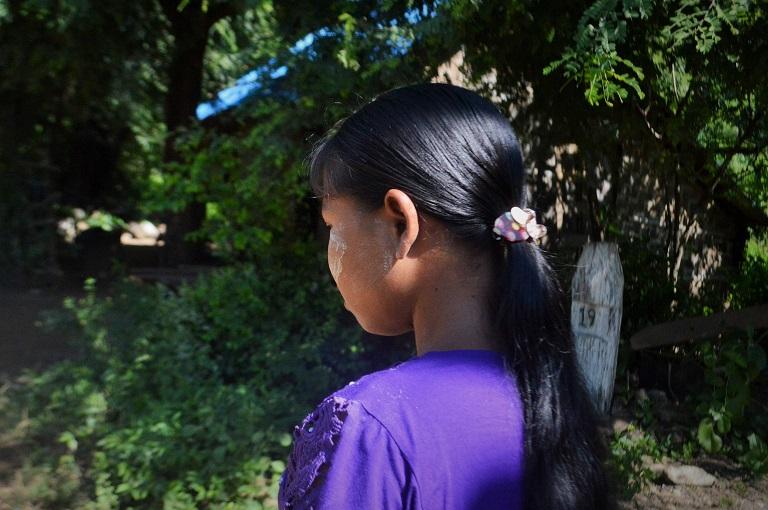
May Thu, an illegal logger in Myanmar who was seriously injured when she fell on a chainsaw. (Poppy McPherson | Mongabay)
But the trade has survived, and thrived, by going underground.
For locals here in the heart of Myanmar’s logging country, the commercial timber trade – though prohibited – is a major source of employment. Bald hills, once thickly forested, are testament to the enormous impact of the industry in recent years. Myanmar’s dense forests, long prized for rare and valuable Burmese teak (Tectona grandis), Burmese rosewood (Dalbergia oliveri) and Burma paduak (Pterocarpus macrocarpus), are prime real estate for logging.
Logging country
On recent visits to northern and central Myanmar as part of months-long investigations into illegal logging by Mongabay reporters, at least a dozen local officials, villagers, and traffickers said the trade continues. In one village, logs were openly transported and stored outside homes.
North of Mandalay, Sagaing Division and neighboring Kachin and Shan states have borne the brunt of deforestation, according to officials.
“There are so many arrested illegal loggers… every day,” said Kyaw Zaw, director of the Ministry of Natural Resources and Conservation. “There has even been an attack on our staff by illegal loggers.”
He added that they are going against the tide in their efforts to curb illegal activity because the demand is so high.
“We are trying to stop it,” he said.
But in some towns, signs of the industry are everywhere.
On the banks of the Irrawaddy River is Katha, a sleepy town in northern Sagaing, sandwiched between Kachin and Shan, which serves as a transit hub for the trade. Red notice boards warn residents of the penalties for logging: $15 and up to two years in jail for “extracting, moving, keeping in possession unlawfully timber.” Some of the timber cut locally is smuggled onto boats at the jetty for transport, according to one local man who showed pictures of logs being loaded into the false bottom of a boat, a common practice.
“The profession of this town is logging,” said Kyal Ni, the local information officer for the ruling National League for Democracy, over a cup of milky Burmese tea in a Katha teashop.
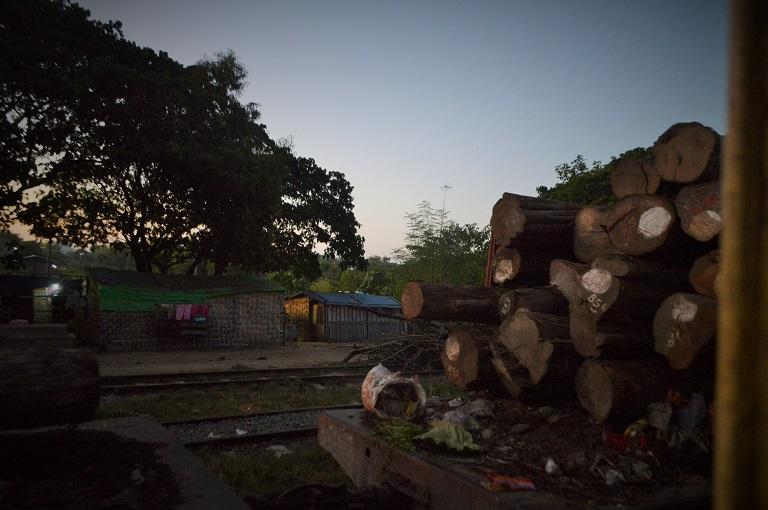
Logs in transit by train on the Mandalay to Myitkyina line. (Poppy McPherson | Mongabay)
“At this time it is really hard to get detailed information about illegal logging because it’s really secret,” he said. “Before, it was quite easy [to stay informed].”
One thing that hasn’t been kept in the shadows: chainsaws. Permits are required in Myanmar to legally use chainsaws in disaster management or to build homes. Yet Kyal Ni said they are still openly sold and rented on the local market illegally.
The Forestry Department oversees the issuance of import licenses for the tools, but the central government has recently pledged to play a greater role in overseeing distribution and has publicized seizures of “illegal” saws.
“I don’t know much about chainsaws,” said one local shopkeeper familiar with the trade, who would not give his name. “But when they came into this industry, it was ruined. When I was young I never saw chainsaws in the industry. It was because people were very greedy and they just wanted to produce a lot, a lot.”
For many illegal loggers, the potential payoff is worth the obvious risks.
In 2013, according to Myanmar’s official statistics, the country exported over $580 million in wood products, most of it made up of the sale of teak logs to India.
But, that same year, imports of wood products from Myanmar of twice the value were officially declared by China ($619 million) and India ($535 million), suggesting that much of the wood was smuggled out of Myanmar without being recorded in its official statistics.
The trade transited mostly out of Kachin state according to a report by the London-based Environmental Investigation Agency (EIA).
By 2015, Myanmar’s government said that its exports of wood products had plummeted to $86 million. The wood imports declared by China and India also dropped significantly but remained twice as high as Myanmar’s official exports ($179 million), hinting that smuggling continued. In a 2015 report, the EIA estimated that timber smuggling between Myanmar and China was worth half a billion dollars a year.

Source: Myanmar Customs Department (Mongabay)
The EIA report and multiple first-hand accounts indicate that logging company bosses and corrupt officials reap the profits of the trade. They also make it clear that poor villagers bear the brunt of the risk by doing dangerous and illegal work. It’s not just the threat of jail – the tools of production have become increasingly risky.
According to multiple interviews with loggers, doctors and medical professionals, injury and even death is becoming common for those who to choose work in an already hazardous industry without guidance or protective gear when employing a chainsaw.
The precise number of injuries and fatalities is unknown due to the secrecy that surrounds the underground trade and a dearth of records in the health sector.
Dangerous business
For decades, loggers in Myanmar cut down trees by hand, with manual saws. Or they captured wild elephants and trained them to fell trees – a practice that continues today in parts of the country.
That has changed over recent years, following an influx of Chinese-made chainsaws. In 2015, China and Singapore declared exporting more than 114,000 chainsaws to Myanmar, more than in any previous years. That represents the vast majority of the more than 118,000 chainsaw exports reported by all countries to Myanmar, according to UN Comtrade data.
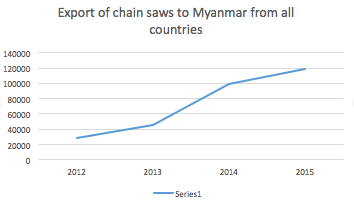
Source: UN Comtrade Data (Mongabay)
Myanmar’s Ministry of Commerce did not respond to multiple requests for data on chainsaw imports.
According to loggers, chainsaws can be bought or rented for several months for under $100. They cut trees five times as fast as a manual saw. But one serious mistake, like May Thu’s, can happen with only a momentary lapse in concentration.
Medical reports posted on U.S.-based chainsaw safety training websites list ghastly accidents:
“Deceased fell backward while operating a chainsaw and the handle struck him in the chest – torn liver, blunt trauma to chest and abdomen.”
“Attempted to remove tree branch from high tension wire with chainsaw – electrocution.”
“Burned inside of arm while using chainsaw cutting fence posts at farm… septic shock, infected burn, cellulitis, renal failure.”
Global timber industry experts recommend employees invest, at minimum, in a helmet with a face screen and ear protection, steel-toed, cut-resistant boots and gloves. In the forests of remote Myanmar, where most villagers wear flip flops, little of that is available or even deemed necessary.
A freelance life or death trade
May Thu’s home is on the edge of the forest, in an isolated village, accessible only by crossing a river. Locals go back and forth in rickety wooden boats riddled with holes to reach the city where their wood will be sold.
They said in interviews that they send shipments of wood back the other way on rafts, paying local officials to open the jetty, which was closed after the ban.
May Thu and Myint Swe say they have worked in the business for several years as freelancers who sell their haul to local brokers. They know people who work directly for some of the shadowy logging companies running professional operations deep in the forest.
It’s better pay, they said, but there are rumors of thuggish tactics and exploitation. Some companies are said to pay their employees with methamphetamines, fueling the drug addiction that ravages vast swaths of the country.
After a few chainsaws arrived in their village from neighboring Shan state in early 2016, the couple decided to rent one from a neighbor. They hoped it would bring them more money, faster. They were saving up to see a doctor about fertility problems. Myint Swe was crazy to have a kid.
Many illegal loggers still use hand saws and nobody gave much instruction on how to use the new tool. They had no protective clothing.
“I had never used chainsaws before, it is very hard to know how to operate them,” said Myint Swe.
The accident happened on the first day.
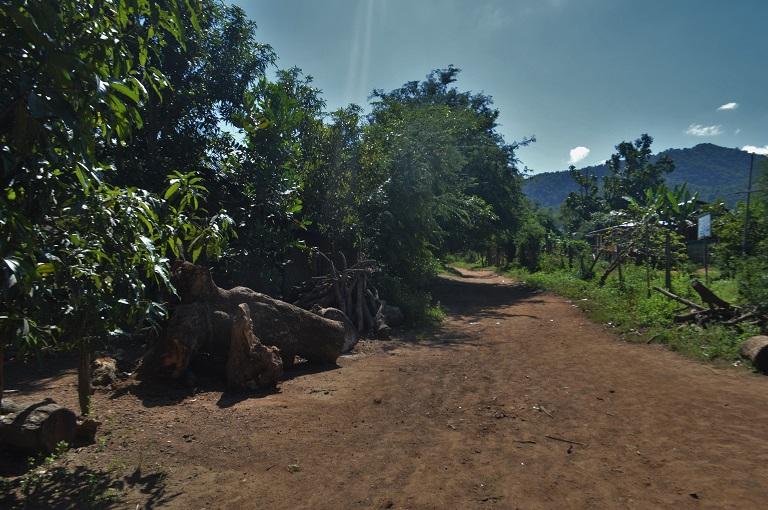
Logs piled up outside villagers’ houses in Mandalay Region. (Poppy McPherson | Mongabay)
In the panicky aftermath, with May Thu bleeding heavily, most of the villagers thought she would die. Her father ran from house to house screaming. He “went crazy” recalls the couple, begging people to lend money to rent a car to drive to the hospital – a two-hour journey – and pay for treatment.
They borrowed more than $700 and made it to a hospital in time for emergency surgery. May Thu had 50 stitches and was in the hospital for 13 days.
Maung Maung, the first doctor who treated her, said options are limited for such patients.
“They know that [using] the chainsaw is very risky, but they don’t have anything [else] to do,” he said.
Much of the logging in Myanmar takes place in extremely remote forests where anyone injured is unlikely to make it to hospitals in urban centers.
Contacted by phone, a 27 year-old logger in Mabein township, northern Shan state, said he sliced off his thumb the first day he used the chainsaw and was treated at a local private clinic.
“Now I have no thumb on my left hand,” he said.
Tricky treatment and data
It’s hard to determine exactly how many people have been injured by chainsaws in Myanmar. The data simply isn’t centralized – there’s no national database and reliable statistics are extremely scarce. Health records are not typically digitized and townships have not compiled data.
However, interviews and data obtained from selected townships with the help of regional medical professionals shows a cross-section of chainsaw-related injuries that is likely typical of areas with significant logging activity.
There are roughly 20 townships per Myanmar’s 14 states, but not every township has the same amount of logging activity, so numbers could vary depending on the region. Based on estimates obtained during field reporting in a limited number of townships, dozens of people were injured in 2016 alone. The real number is likely higher.
In several clinics consulted first hand and through intermediary medical professionals, staff painstakingly examined paper record books by hand to find chainsaw-related cases. It is highly likely that the number of injuries in those paper records were incomplete, due to poor record-keeping practices.
In Madaya Township alone in 2016, records show that at least five people injured by chainsaws were treated in a handful of private clinics. Among them was a 12 year-old boy who lopped off his thumb. Others slashed tendons and toes.
None of the government officials interviewed provided any information about chainsaw injuries.
“There are lots of [medical] registers – recording things like abortions – but not chainsaw injuries,” said Myo Min, the medical officer in Madaya Township, Mandalay Region, close to where May Thu was injured.
Sitting in an office inside the hospital – a yellow-painted one-story building with flickering lights – he said he had seen at least a dozen cases during several years’ of experience in hospitals in various parts of the country.
Some loggers injured on the job who do make it to a health center try to conceal the real cause of the injury, out of fear of arrest, he said.
Recently, a grievously injured man arrived at the hospital in Madaya. He was declared dead on arrival. His friends told the staff he had crashed his motorbike but medical exams found he had been crushed to death – by a pile of logs.
“It wasn’t because of a motorbike accident – it was because of logging,” said medical officer Myo Min, who was at the hospital when the victim arrived. “The logs fell down on his body and broke all of his ribs.”
Myint Swe and May Thu, who knew the man, confirmed the story.
Such is the nervousness that surrounds logging that one doctor interviewed claimed to have only seen one or two injuries caused by chainsaws, while medical records shared by a senior official showed he had treated several others, some prior to 2016.
Myo Min said he also saw many chainsaw injuries while he was stationed in Mabein Township, northern Shan state, near the Chinese border. Once, he said he saw the aftermath of a murder: two men had set upon each other with chainsaws.
The central hospital there, which only treats the most severe cases, treated two people this year.
“Except for during the rains, and the time when [loggers] get arrested [during crackdowns], there will be patients like this,” said Myo Min.
Tragic consequences
May Thu was lucky to survive her injuries. But it has cost her dearly.
She and her husband are now heavily indebted. They haven’t been able to have sex since the accident. A trip to the fertility doctor in hopes of having a child now looks distant.
May Thu’s wound also continues to fester and is filled with pus. She hasn’t been able to afford a trip to the doctor to pay for the stitches to be removed. Instead, she eats the bitter-tasting leaves from the thanaka tree, a type of traditional medicine.
“I prefer Western medicine but I can’t afford to buy Western medicine,” she said. Her husband continues to log illegally, and May Thu tries, too.
“The life is tough,” she said. But it’s easier and far more profitable than the alternatives: farming or selling bamboo. The villagers have given her a macabre new nickname: “Miss Chain Saw.”
This article was first published by Mongabay and appears here with permission. Names of the loggers have been changed to protect their identities. Additional reporting by Saw Nang, Aung Naing Soe, Cape Diamond, and Emmanuel Freudenthal.


